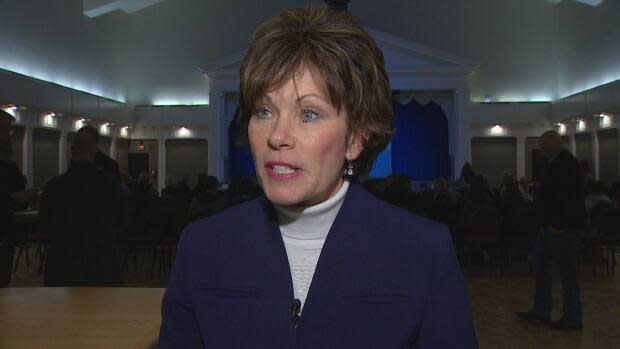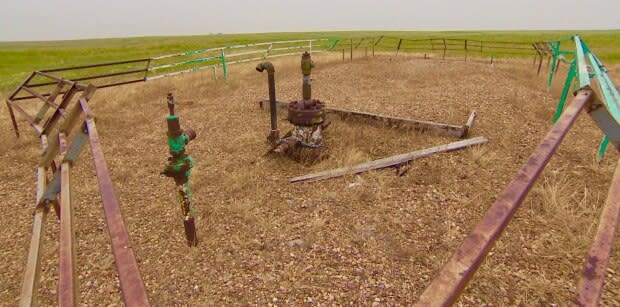Alberta overhauls system to clean up old oil and gas wells, with 90,000 sitting idle

The Alberta government is revamping how it regulates oil and gas producers in an attempt to start addressing the province's swelling inventory of inactive oil and gas wells.
The biggest change will be introducing a requirement for companies to spend a minimum amount of money every year toward cleanup of oil wells, pipelines and facilities.
Alberta has more than 90,000 inactive wells, in addition to 73,000 abandoned wells that have been dismantled but not fully reclaimed. The estimated cost of cleanup varies greatly but is considered to be in the tens of billions of dollars.
The government will formally announce the new program on Thursday. Many experts are welcoming the changes, even though it may not result in companies having to spend more money on reclamation work.
Energy Minister Sonya Savage is hopeful the new annual targets will help to address the problem.
"It's like paying down a mortgage. You've got a target and every year you're chipping away at it, paying it down and eventually you'll have that mortgage paid off. That's what the inventory reduction and the requirement for annual spending targets will do," she said in an interview.
"Over time, we will get that cleaned up."

Savage said companies may be required to spend at least four per cent of the estimated cost of their inactive wells, which would increase over time.
Still, the exact percentage is still to be determined and it's not clear whether there will be any enforcement, which will be the responsibility of the Alberta Energy Regulator (AER).
"We'll work with industry to make sure they can reach those targets. You can't be setting targets too high that they can't meet. That's not helpful for anyone," she said.
"The AER will work on what kind of feasible penalties, if any, there would be. But we're telling them these [spending targets] need to be mandatory."
The provincial government will give the regulator extra powers to gauge the financial health of companies, with the goal of intervening earlier when producers begin to struggle, which raises the risk that their cleanup liabilities may not be addressed.

That's a good approach, according to Tristan Goodman, president of the Explorers and Producers Association of Canada, which represents small- and medium-sized oil and gas producers. He worked at the AER several years ago.
"As a former regulator, what you're looking for there is to understand the financial position of those companies and how to make sure that the companies know the regulator is paying greater attention to them."
Goodman said the finer details of the changes will be important, but in general, he supports the overhaul of the program.
At this point, he said, it is not clear whether there will be an added financial burden on industry, depending on how much individual companies are already spending on cleanup.
"I think in some cases there could be. I think that is acceptable," he said.
"The best outcome … is to make sure companies are consistently spending and consistently reclaiming as they go, and when that doesn't happen, that's when you get into a situation where you do have a potential broader problem."
To this point, Alberta has relied on a liability management system that is supposed to make sure companies are financially healthy enough to pay for cleanup later on.
If a company's estimated assets fall below the cost of its environmental liabilities, the AER can collect a security deposit.
But the regulator has been using a formula based on out-of-date commodity prices that inflated the assets of companies. As a result, companies were not asked to put down large enough security deposits for future cleanup.
The energy minister is describing the changes as a bold step after decades of inaction by former governments, even as the problem grew larger year after year.
Some critics have called for the introduction of timelines for when wells need to be cleaned up similar to the rules in some other jurisdictions in North America. Savage said timelines would be ineffective because other provinces and states don't have the same magnitude as Alberta's number of inactive wells.
The total cleanup bill and possible environmental damage from inactive wells is a difficult problem to tackle, said Lucija Muehlenbachs, an economist at the University of Calgary who specializes in the energy industry.
"We're in so much trouble. I think, with the liabilities situation of old oil and gas wells in Alberta, that this program probably won't change that much, but it's certainly a step in the right direction," she said.
"We will have inactive wells and probably a lot of inactive wells for many years to come."

Landowners will now have a way to address old wells on their property that are sitting idle as they will be able to nominate sites to the regulator for cleanup. The oil and gas company would then have to justify why it is not reclaiming the well.
"I've been trying to get governments to address this for decades," said Keith Wilson, a property rights lawyer.
"I do think this is a positive for landowners, a positive for the environment."
Alberta's existing rules for regulating the cleanup of old wells were "a farce," said Wilson, and the new system will start addressing the longstanding problems with inactive wells in the province.
The changes come at a time when the industry is in a precarious position with historically low commodity prices in recent months.
Many critics were lobbying the provincial government to introduce stricter rules, although they also acknowledged there couldn't be too much of a burden on industry, or else many companies could become insolvent and more wells would be left without an owner.

